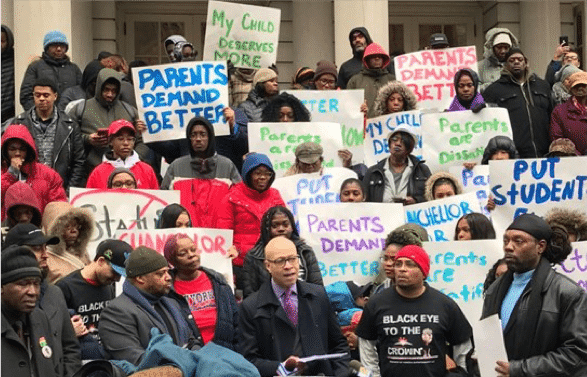PUBLIC ACTIONS
Public Actions are carefully organized and choreographed events to demonstrate a community’s power. Some public actions are opportunities to ‘pin’ a public figure to publicly state their position on a campaign agenda.
Downloadable measurement template
Below is a template of common measures organizations use in the parent empowerment space to manage public actions.
As a reminder, your organization should ‘Goldilocks’ what it measures. You should only capture measures that help your organization make better decisions to increase impact (and are practical to collect).
Overview of public actions

Public actions are "political theatre," notes David Walls.1
Public actions are a very public expression of a community’s power in issue (voice) campaigns or electoral (vote) campaigns.
Public actions can be an event held by an organization or can be at either another organization’s or public body’s event – such as a school board meeting.
Public actions are planned with significant detail in mind – both content and structure. To paraphrase an old military saying, “strategy and tactics are nothing without logistics.” Organizations planning successful public actions invest heavily in the logistics to ensure turnout and the choreographed execution of a public action (for an example of this, please see Key Lessons From a ‘Blue Ribbon’ School in Los Angeles: 3 Ways to Build an Effective — and Enduring — Education Agenda.)
Some tips for successful public actions:
- Be clear on the objective of a public action:
- Who specifically are you trying to influence?
- How does this determine the what, where and when of your public action?
- Ask yourself, what will success look like?
- If the purpose of this public action is to ‘pin’ a public figure to publicly state their position on an agenda, consider when and how to make that clear in advance, what will influence their position, and even what you need to do to ensure they are present at this public action.
- Based on that purpose and definition of success, determine:
- What voices need to be heard in the public action?
- What information needs to be provided and what is the most compelling format?
- What is the right venue and time of day to make this most effective?
- Determine who needs to be at this public action in order for it to be successful:
- Number of people?
- Specific people?
- Members of the media?
- Identify supports you need to provide in order to enable participation. Transportation? Food? Childcare? Parking?
- Make a very clear statement of brand and agenda. Think about t-shirts or signage with a specific message and color that demonstrate a strong, unified message and the power of a large presence in support of your agenda to target audiences.
- Develop clear messaging:
- Develop and practice clear scripts. Public actions are performance.
- Develop clear sound-bites and visual messages – phrases or demands – that are clearly understood, can be easily remembered, and can be easily shared by media and others.
- Consider how to make this message compelling and memorable, such as cheers, or conversely moments of silence on a profound issue, or a procession of people walking to deliver a key message or piece of content to a target audience.
- Activate your infrastructure to ensure turn-out at a public action. Use social media to broadcast an event. Use house meetings and 1-on-1 meetings to invite and confirm people to attend. Follow-up with personal contacts and leverage relationships to confirm turnout.
- If this public action is at another organization or public body’s meeting (such as a school board meeting), research and know the rules, be respectful of them, but also hold that body accountable for abiding by its own rules (such as public comments, open meeting laws, etc.). If possible, seek a formal position on their meeting’s agenda.
- Plan time to debrief after a public action: What went well and why? What could have gone better and why? Did you stick to your plan? Was your goal achieved? What follow-ups were committed to and what are next steps? What learnings can inform future public actions?
- Thank participants for attending.
- Put out summaries of the action, including pictures and video, for easy pick-up by media outlets.
- Publicize the public action through your organization's social media outlets and through partner organizations.
- Always follow up on post-action commitments you have made, and commitments others have made.
1. David Walls, Community Organizing: Fanning the Flames of Democracy (Polity Press, 2015), page 85.

225 Franklin Street, Suite 350
Boston, MA 02110
617.912.8800
This work is licensed under a Creative Commons Attribution-NonCommercial-ShareAlike 2.0 License (CC BY-NC-SA 2.0)
Click Here to learn more.
